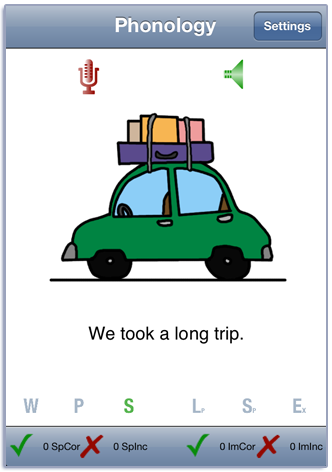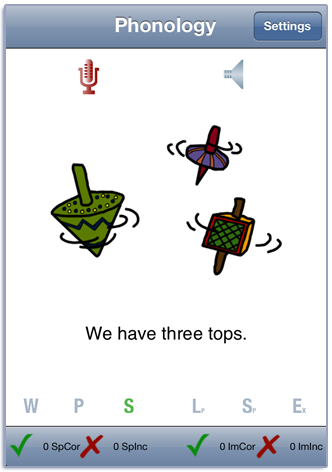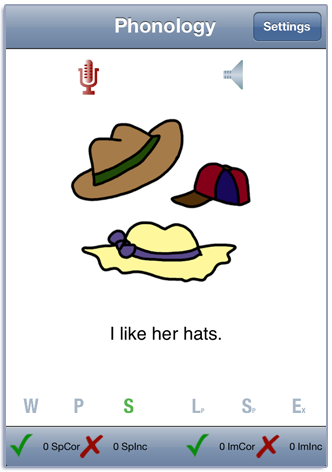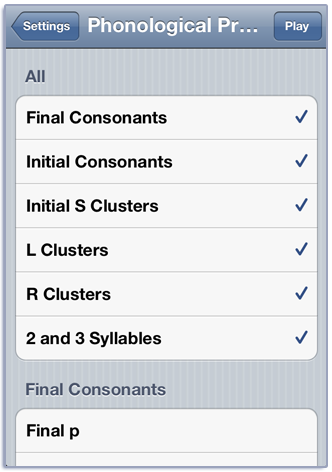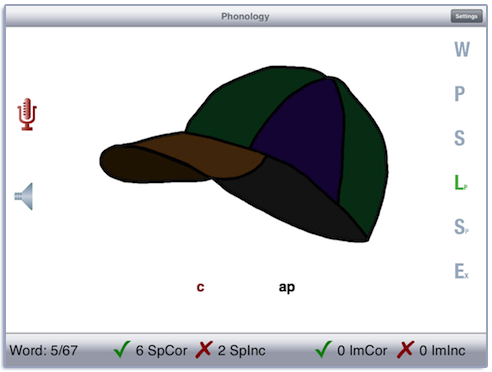Phonology Manual
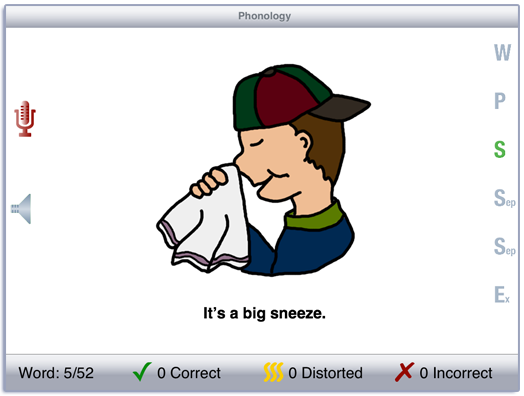
Contents
This app is based on the Word Practice game from LocuTour’s Phonology I CD. It uses a phonological approach to remediating speech that is based on the ideas of Hodson and Paden. The program focuses on target patterns rather than target phonemes. One pattern is targeted for a limited time, two to four weeks, then the next pattern is targeted. Hodson and Paden called this method of introducing patterns a “cycle”. Patterns include: syllable reduction, cluster reduction, prevocalic and postvocalic singleton omission, stridency deletion, velar deviation, liquid deviation, nasal deviation, and glide deviation. Within these patterns, specific phonemes are targeted. Phonology covers Final Consonants, Initial Consonants, and Initial S Clusters, L Clusters, R Clusters, and 2 and 3 Syllable Words.
Play
Tap the Play button to start. A picture is displayed on the screen. Each picture has a word, sounds, phrase, word with a long pause between the target and the rest of the word, word with a short pause between the target and the rest of the word, and a sentence. To hear the word, tap the picture or tap the speech production button labeled W. In landscape view, the speech production buttons are on the right-hand side of the screen. In portrait view, they are at the bottom of the screen. The text of the speech production is shown below the picture. It can be hidden or displayed by toggling the “Show text below picture” button on the Options screen. Swipe right-to-left to move to the next word.
If your device is capable of recording, there will be a microphone and speaker above the picture. Tap the microphone to begin recording. After a short delay it will turn red. After it turns red, say the target word. Tap the microphone again and the speaker will turn green. Tap the speaker to hear the word played back.
Score the child’s speech production using the Spontaneous Correct, Spontaneous Incorrect, Imitative Correct, and Imitative Incorrectbuttons at the bottom of the screen. If the word was pronounced correctly, tap the green check. If not, tap the red x. You can record and score as many times as you wish.
If a sound is playing, the app will ignore taps to the picture and the speech production buttons.
Settings
You view the settings by tapping the Settings button at the top of the main game-play screen or at the bottom of the intro screen.
Pick a phonological process or processes from the Phonological Process option. If you are using the app for therapy, you’ll probably want to focus on just one process at a time. You can select all of the words from Final Consonants, Initial Consonants, and Initial S Clusters, L Clusters. R Clusters, and 2 and 3 Syllable Words or you can pick pick specific patterns within these groups.
To view the word list, tap View Word List. You can download a list of the words from our website.
The Options tab lets you choose from the following stimulus presentation options: Target, in which the stimulus will always be the target word; Foil, in which the stimulus will always be the non-target word; or Either, in which the stimulus will be randomly switched between target and non-target words.
You can a sign in with the child’s name and the app will remember the name until you change it. If you enter a name the results files will be stored with the name appended. e.g. Phonology Results Child One 2015-02-27.html
When you change the name a new file of results will be created. If you want to clear out the current results file, but not change the name, you can touch the Reset Scoring button.
The Results tab shows the results for the day. For each category (or group of categories), the app collects data on the total Visual Presentations (number of screens viewed), Correct productions, Distorted productions, Incorrect productions, and the total Auditory Presentations (the sum of the taps on the picture, and the Phonology and Target buttons). It also reports the percent correct responses to the “Phonology” prompt, if the checkboxes were turned on. A new results file is created when you change the “Sign In” name or when the day changes.
Viewing Results
You can email or print the results from the button at the top of the results page. You may also use iTunes to copy the day’s results file to your computer for printing or archiving. To view the results pages in iTunes, plug your iPad or iPod into your computer. Open iTunes. Under Devices you’ll see your device. Click on the device and look at the top of the screen. You will see a tab lableled iTunes Apps. Under that tab, there is a section for File Sharing. The Phonology app will be displayed. In the documents list next to it you will find all of the results pages that are stored on the device. Drag them to your desktop. They will open in your web browser where you can print them.
Rationale
This task is the basis for phonology therapy. It includes the often necessary step of separating the target sound from the rest of the word. In this way, the error sound can be eliminated from the habitual motor sequence. While playing Word Practice, the client must process auditory information at the sound, syllable, phrase, and sentence levels with imitative or spontaneous expressive phonological production.
Credits
Created by Marna Scarry-Larkin, MA, CCC-SLP and Elizabeth Price, MA, CCC-SLP. Graphics were originally drawn by Marianne Lee and adapted for iOS by Nancy Scarry.
Screen Shots from iPhone and iPad
